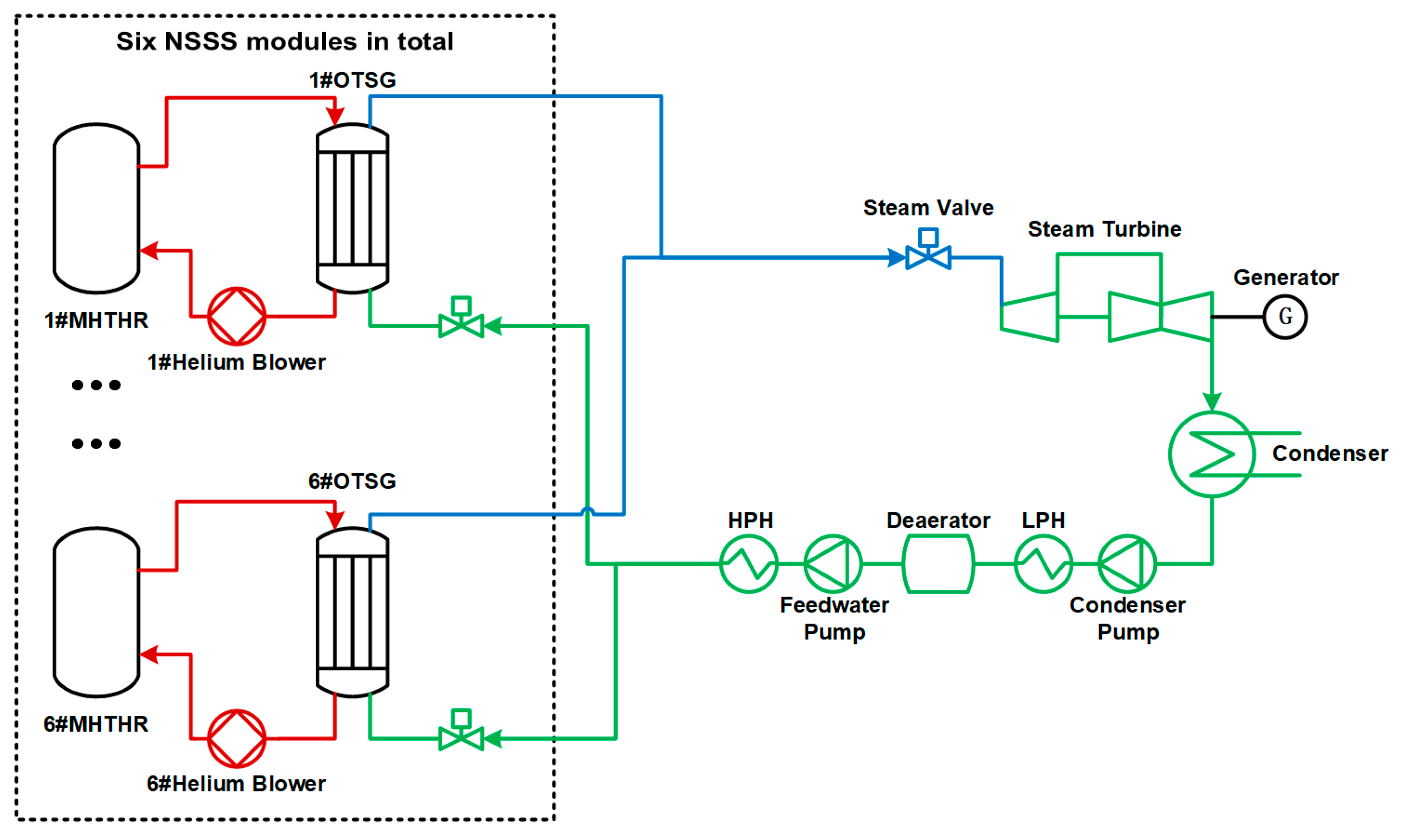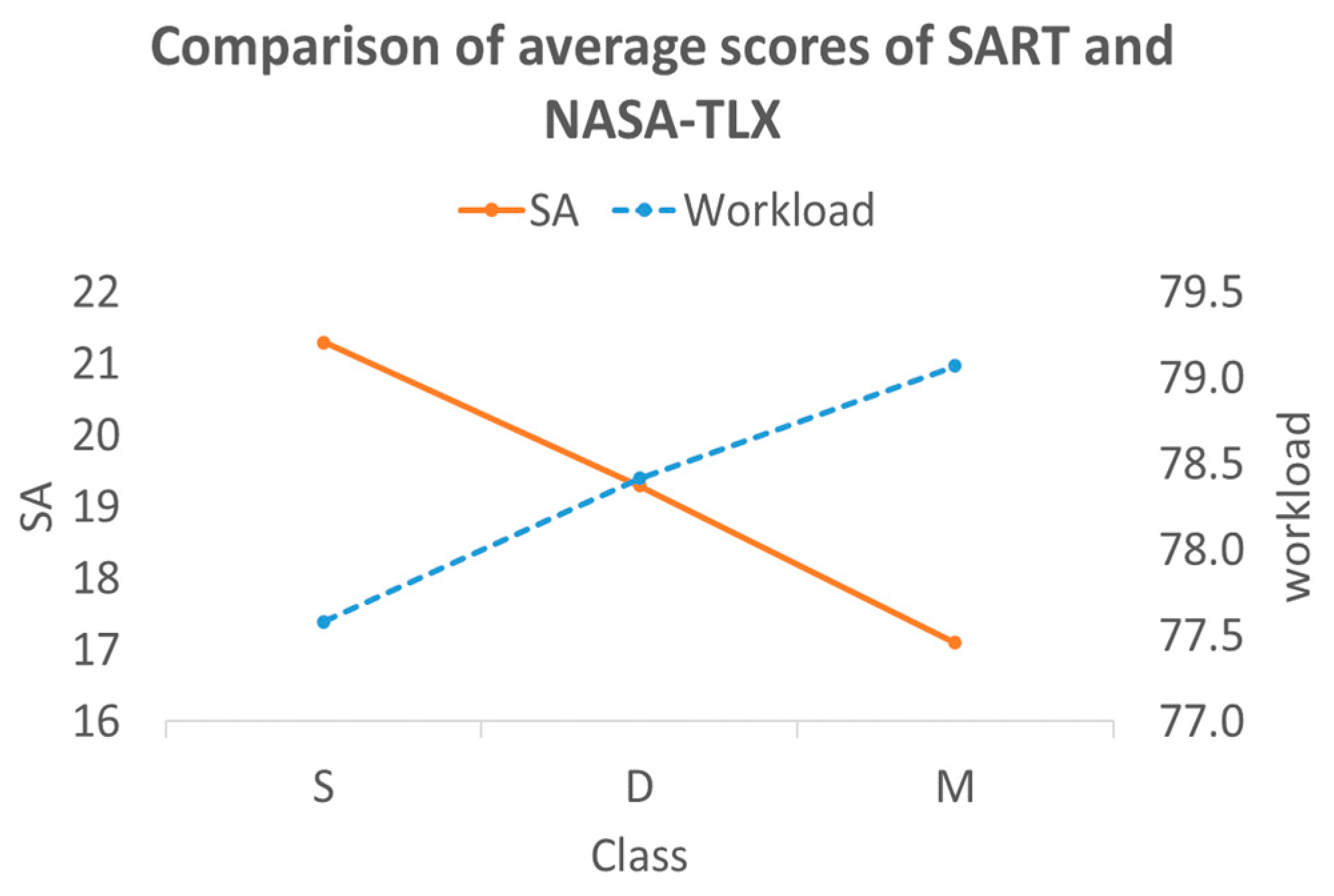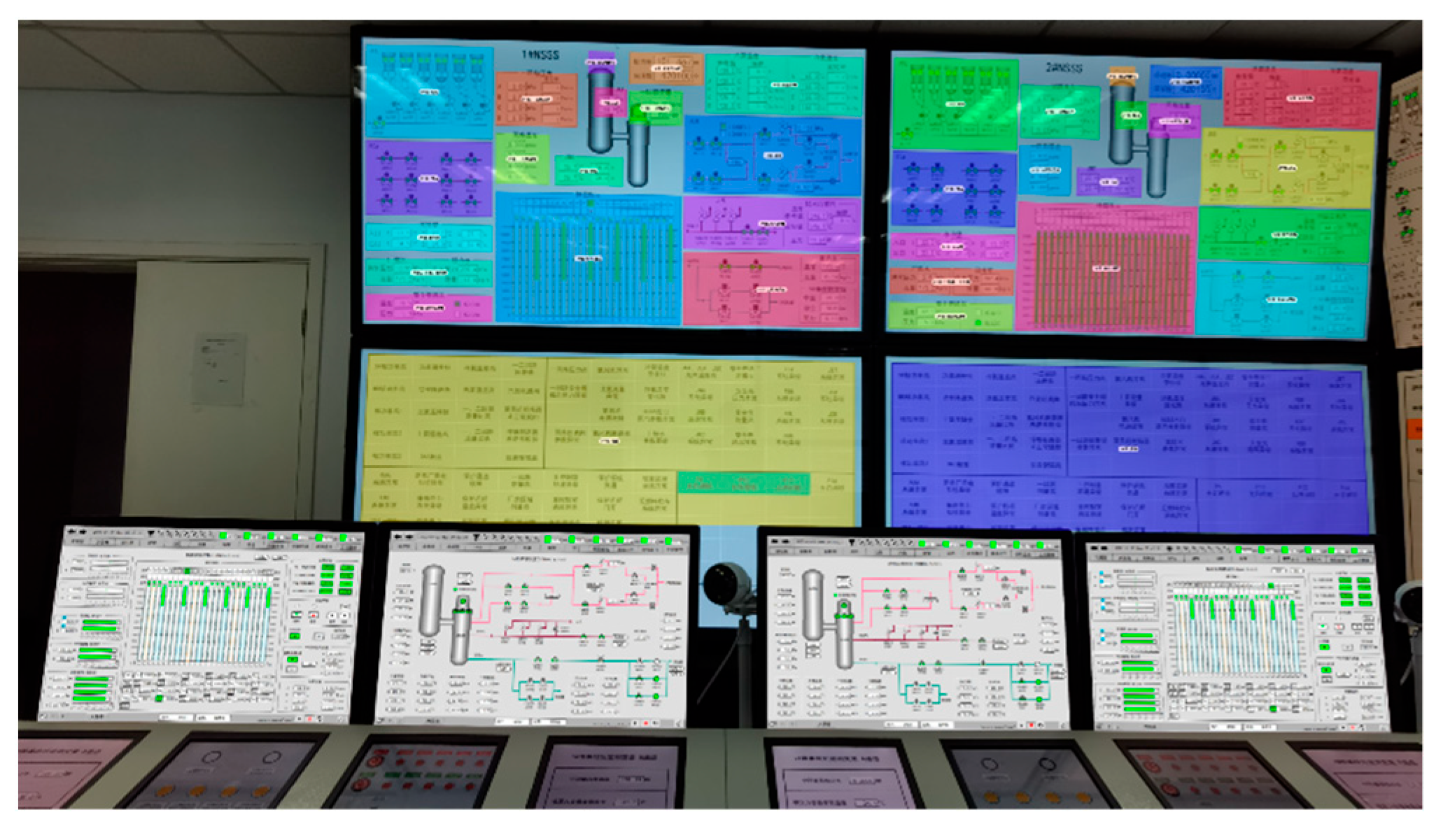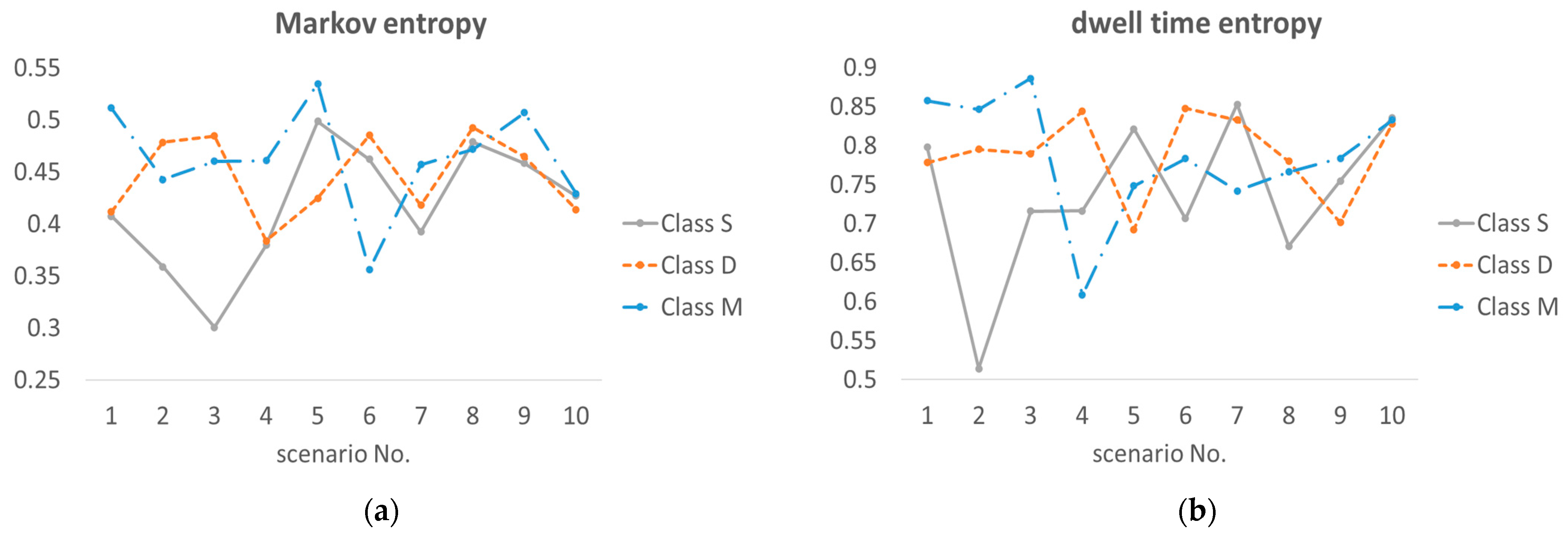A Comprehensive Situation Awareness Measurement Method for Analyzing the Operators’ Situation Awareness of Multi-Module High Temperature Gas-Cooled Reactor Plants
Abstract
:1. Introduction
2. Experimental Methods
2.1. Experimental Participants
2.2. Verification Platform
2.3. Experimental Process
2.4. Experiment Scenarios
3. Statistical Analysis Methods
3.1. Rating Scale
3.1.1. Situation Awareness Rating Technique (SART)
3.1.2. NASA Task Load Index (NASA-TLX)
3.2. Gaze Entropy
3.2.1. Markov Entropy
3.2.2. Dwell Time Entropy
4. Results and Analysis
4.1. Situation Awareness and Workload
4.2. Eye Tracker Hot Spot Map
4.3. Markov Entropy and Dwell Time Entropy
5. Conclusions
Author Contributions
Funding
Data Availability Statement
Conflicts of Interest
References
- Le Bot, P. Human reliability data, human error and accident models—Illustration through the Three Mile Island accident analysis. Reliab. Eng. Syst. Saf. 2004, 83, 153–167. [Google Scholar] [CrossRef]
- Radziwill, N.M. Designing for Situation Awareness: An Approach to User-Centered Design, Second Edition. Qual. Manag. J. 2017, 24, 56. [Google Scholar] [CrossRef]
- Salmon, P.; Stanton, N.; Walker, G.; Green, D. Situation awareness measurement: A review of applicability for C4i envi-ronments. Appl. Ergon. 2006, 37, 225–238. [Google Scholar] [CrossRef] [Green Version]
- Bustamante, E.A.; Fallon, C.K.; Bliss, J.; Bailey, W.R.; Anderson, B.L. Pilots’ workload, situation awareness, and trust during weather events as a function of time pressure, role assignment, pilots’ rank, weather display, and weather system. Int. J. Appl. Aviat. Stud. 2005, 5, 347–367. [Google Scholar]
- Stark, J.M.; Comstock, J.R.; Prinzel, L.J.; Burdette, D.W.; Scerbo, M.W. A Preliminary Examination of Situation Awareness and Pilot Performance in a Synthetic Vision Environment. Proc. Hum. Factors Ergon. Soc. Annu. Meet. 2001, 45, 40–43. [Google Scholar] [CrossRef]
- Burke, K.A.; Wing, D.J.; Haynes, M. Flight Test Assessments of Pilot Workload, System Usability, and Situation Awareness of Tasar. Proc. Hum. Factors Ergon. Soc. Annu. Meet. 2016, 60, 61–65. [Google Scholar] [CrossRef]
- Kilingaru, K.; Tweedale, J.W.; Thatcher, S.; Jain, L.C. Monitoring pilot ‘Situation Awareness’. J. Intell. Fuzzy Syst. 2013, 24, 457–466. [Google Scholar] [CrossRef]
- Van de Merwe, K.; van Dijk, H.; Zon, R. Eye Movements as an Indicator of Situation Awareness in a Flight Simulator Experiment. Int. J. Aviat. Psychol. 2012, 22, 78–95. [Google Scholar] [CrossRef]
- Ha, J.S.; Byon, Y.-J.; Baek, J.; Seong, P.H. Method for Inference of Operators’ Thoughts from Eye Movement Data in Nu-clear Power Plants. Nucl. Eng. Technol. 2016, 48, 129–143. [Google Scholar] [CrossRef] [Green Version]
- Selcon, S.J.; Taylor, R.M.; Shadrake, R.A. Multi-Modal Cockpit Warnings: Pictures. Words. or Both? Proc. Hum. Factors Soc. Annu. Meet. 1992, 36, 57–61. [Google Scholar] [CrossRef]
- Selcon, S.J.; Taylor, R.M.; Koritsas, E. Workload or Situation awareness?: TLX vs. SART for Aerospace Systems Design Evaluation. Proc. Hum. Factors Soc. Annu. Meet. 1991, 35, 62–66. [Google Scholar] [CrossRef]
- The Rate of Gain of Perceived Workload in Sustained Attention|Semantic Scholar. Available online: https://www.semanticscholar.org/paper/The-Rate-of-Gain-of-Perceived-Workload-in-Sustained-Dember-Warm/cfd83fe9855b67bc8212393fca8882bea134c96f (accessed on 23 November 2022).
- Zhang, Z.; Dong, Y.; Li, F.; Zhang, Z.; Wang, H.; Huang, X.; Li, H.; Liu, B.; Wu, X.; Wang, H.; et al. The Shandong Shidao Bay 200 MW e High-Temperature Gas-Cooled Reactor Pebble-Bed Module (HTR-PM) Demonstration Power Plant: An Engineering and Technological Innovation. Engineering 2016, 2, 112–118. [Google Scholar] [CrossRef] [Green Version]
- Zhang, Z.; Wu, Z.; Wang, D.; Tong, J. Development Strategy of High Temperature Gas Cooled Reactor in China. Chin. J. Eng. Sci. 2019, 21, 12–19. [Google Scholar] [CrossRef] [Green Version]
- Dong, Z.; Song, M.; Huang, X.; Zhang, Z.; Wu, Z. Module Coordination Control of MHTGR-Based Multi-Modular Nuclear Plants. IEEE Trans. Nucl. Sci. 2016, 63, 1889–1900. [Google Scholar] [CrossRef]
- Seong, P.-H. (Ed.) Reliability and Risk Issues in Large Scale Safety-Critical Digital Control Systems, 2009th ed.; Springer: London, UK, 2008. [Google Scholar]
- Wu, Z.; Lin, D.; Zhong, D. The design features of the HTR-10. Nucl. Eng. Des. 2002, 218, 25–32. [Google Scholar] [CrossRef]
- Yanhua, Z.; Zhipeng, C.; Han, Z. Preliminary study on HTR-10 operating at higher outlet temperature. Nucl. Eng. Des. 2022, 397, 111958. [Google Scholar] [CrossRef]
- Xu, Y.; Zuo, K. Overview of the 10 MW high temperature gas cooled reactor—Test module project. Nucl. Eng. Des. 2002, 218, 13–23. [Google Scholar] [CrossRef]
- Taylor, R. Situational Awareness Rating Technique (Sart): The Development of a Tool for Aircrew Systems Design. In Situational Awareness; Routledge: Oxfordshire, UK, 2011. [Google Scholar]
- Hart, S.G.; Staveland, L.E. Development of NASA-TLX (Task Load Index): Results of Empirical and Theoretical Research. Adv. Psychol. 1988, 52, 139–183. [Google Scholar]
- Ujita, H. Human characteristics of plant operation and man-machine interface. Reliab. Eng. Syst. Saf. 1992, 38, 119–124. [Google Scholar] [CrossRef]
- Bhavsar, P.; Srinivasan, B.; Srinivasan, R. Quantifying situation awareness of control room operators using eye-gaze behavior. Comput. Chem. Eng. 2017, 106, 191–201. [Google Scholar] [CrossRef]
- Allsop, J.; Gray, R. Flying under pressure: Effects of anxiety on attention and gaze behavior in aviation. J. Appl. Res. Mem. Cogn. 2014, 3, 63–71. [Google Scholar] [CrossRef]
- Lee, Y.; Jung, K.; Lee, H. Gender Characteristics on Gaze Movement in Situation Awareness. Appl. Sci. 2021, 11, 10281. [Google Scholar] [CrossRef]
- Shic, F.; Chawarska, K.; Bradshaw, J.; Scassellati, B. Autism, eye-tracking, entropy. In Proceedings of the 2008 7th IEEE International Conference on Development and Learning, Monterey, CA, USA, 9–12 August 2008; pp. 73–78. [Google Scholar]
- Shannon, C.E. A mathematical theory of communication. Bell Syst. Tech. J. 1948, 27, 379–423. [Google Scholar] [CrossRef] [Green Version]
- Lee, Y.; Jung, K.-T.; Lee, H.-C. Use of gaze entropy to evaluate situation awareness in emergency accident situations of nuclear power plant. Nucl. Eng. Technol. 2021, 54, 1261–1270. [Google Scholar] [CrossRef]
- Shiferaw, B.; Downey, L.; Crewther, D. A review of gaze entropy as a measure of visual scanning efficiency. Neurosci. Biobehav. Rev. 2019, 96, 353–366. [Google Scholar] [CrossRef] [PubMed]
- Lee, Y.; Jung, K.T.; Lee, H.C. A Basic Study on the Use of Eye Movement Entropy in the Emotional Satisfaction Evaluation of Design. J. Ergon. Soc. Korea 2020, 39, 487–500. [Google Scholar] [CrossRef]










| Class | No. |
|---|---|
| S | S1–S10 |
| D | D1–D10 |
| M | M1–M10 |
| Class | Correlation |
|---|---|
| S | −0.74 |
| D | −0.69 |
| M | −0.78 |
Disclaimer/Publisher’s Note: The statements, opinions and data contained in all publications are solely those of the individual author(s) and contributor(s) and not of MDPI and/or the editor(s). MDPI and/or the editor(s) disclaim responsibility for any injury to people or property resulting from any ideas, methods, instructions or products referred to in the content. |
© 2023 by the authors. Licensee MDPI, Basel, Switzerland. This article is an open access article distributed under the terms and conditions of the Creative Commons Attribution (CC BY) license (https://creativecommons.org/licenses/by/4.0/).
Share and Cite
Miao, R.; Jia, Q.; Li, D.; Dong, Z. A Comprehensive Situation Awareness Measurement Method for Analyzing the Operators’ Situation Awareness of Multi-Module High Temperature Gas-Cooled Reactor Plants. Energies 2023, 16, 5601. https://doi.org/10.3390/en16155601
Miao R, Jia Q, Li D, Dong Z. A Comprehensive Situation Awareness Measurement Method for Analyzing the Operators’ Situation Awareness of Multi-Module High Temperature Gas-Cooled Reactor Plants. Energies. 2023; 16(15):5601. https://doi.org/10.3390/en16155601
Chicago/Turabian StyleMiao, Runfa, Qianqian Jia, Duo Li, and Zhe Dong. 2023. "A Comprehensive Situation Awareness Measurement Method for Analyzing the Operators’ Situation Awareness of Multi-Module High Temperature Gas-Cooled Reactor Plants" Energies 16, no. 15: 5601. https://doi.org/10.3390/en16155601
APA StyleMiao, R., Jia, Q., Li, D., & Dong, Z. (2023). A Comprehensive Situation Awareness Measurement Method for Analyzing the Operators’ Situation Awareness of Multi-Module High Temperature Gas-Cooled Reactor Plants. Energies, 16(15), 5601. https://doi.org/10.3390/en16155601







